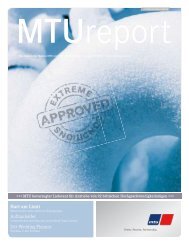English - MTU Onsite Energy
English - MTU Onsite Energy
English - MTU Onsite Energy
You also want an ePaper? Increase the reach of your titles
YUMPU automatically turns print PDFs into web optimized ePapers that Google loves.
Leading international energy companies are spending<br />
heavily on offshore platforms, pipelines and floating<br />
storage vessels.<br />
Floating Production Storage and Offloading (FPSO)<br />
vessels like this store and process oil until tankers<br />
arrive to receive it and transport it to land.<br />
The otherwise tranquil coastal waters off<br />
Brazil bustle with all of the drilling, processing<br />
and transportation activity you would expect in<br />
a country that sits on roughly 11.7 billion barrels<br />
of oil and has taken its place among the world’s<br />
thriving economies.<br />
Six thousand miles to the northeast in the North<br />
Sea, a mammoth drilling platform hovers over<br />
Norway’s Gjoa oil and gas field. Underneath it is<br />
a proven reserve of 1.3 trillion cubic feet of natural<br />
gas and 82 million barrels of oil. Two hundred<br />
miles to the south— just a stone’s throw, really,<br />
in the context of a planet’s surface that’s 70 percent<br />
water— the United Kingdom awaits the<br />
arrival of two new drilling rigs that will produce<br />
three billion barrels off the coast of the Shetland<br />
Islands. And half a world away, preparations are<br />
being made eighty miles off the northwest coast<br />
of Australia to host the largest ultra-deepwater<br />
drilling platforms ever built. Eventually the semisubmersible<br />
rigs will preside over the new<br />
Gorgon Development in the Indian Ocean — and<br />
9.6 trillion cubic feet of natural gas, the energy<br />
equivalent of 2.25 billion barrels of oil.<br />
The world has never needed more oil and gas<br />
than right now, and the technology and equipment<br />
required to locate, extract and distribute<br />
those fossil fuels from deep offshore fields have<br />
never been in greater demand. In the last 10<br />
years, more than half of new global oil and gas<br />
reserves were discovered offshore. According to<br />
global energy research firm HIS, “Deepwater and<br />
ultra deepwater discoveries are becoming the<br />
dominant source of new reserve additions,<br />
accounting for 41% of total new reserves.” Extracting<br />
oil and gas from the bottom of the world’s<br />
oceans is very different than doing so on land.<br />
But the two tasks do share one defining characteristic:<br />
Neither is getting any easier.<br />
Riding the wave<br />
Given the drilling challenges and current and<br />
projected global demand for fossil fuels, leading<br />
international energy companies like Petrobras,<br />
Chevron, BP, ExxonMobil and others are spending<br />
heavily on offshore platforms, pipelines and floating<br />
storage vessels. It’s a wave of investment in<br />
specialized capital equipment that’s driving offshore<br />
oil and gas output to unprecedented levels.<br />
David Oliphant, <strong>MTU</strong> Global Director of Oil & Gas<br />
Sales and Sales Engineering, says the wave<br />
reflects significant changes in offshore energy<br />
production techniques over the last few years.<br />
“Traditional deepwater platforms are being joined<br />
offshore by new methods and equipment to drill,<br />
process and store oil and gas, such as semi-submersible<br />
platforms, drill ships and FPSOs (floating,<br />
productions, storage and offloading units).<br />
Contractors are now working in deeper water<br />
more frequently, and we have powerful engines<br />
that meet their needs. It’s a whole new game,”<br />
he adds.<br />
Conventional drilling platforms are gigantic floating<br />
rigs that are partially constructed on land,<br />
towed far out to sea and eventually secured in<br />
place over a deepwater oil or gas field. But as demand<br />
for energy has grown, new offshore drilling<br />
and processing technologies have been developed<br />
to keep pace. <strong>MTU</strong> has kept stride with that<br />
evolution, according to Robert Wagner, Senior<br />
Manager Oil & Gas, <strong>MTU</strong> Friedrichshafen GmbH.<br />
“Customers rely on our high quality, reliable<br />
equipment. We work very closely with our customers<br />
and their contractors at the early stage of<br />
each project, and provide technical and commercial<br />
information for effective project planning,”<br />
Wagner explains. The benefits of this approach<br />
are clear. The earlier that <strong>MTU</strong> is involved in the<br />
planning process for an offshore energy project,<br />
the better the results will be for the contractors<br />
who build and operate the equipment utilized,<br />
and for the energy company funding the projects.<br />
Breakthrough in Brazil<br />
Engevix (Florianopolis, Brazil), a major shipyard,<br />
purchased sixteen generators powered by <strong>MTU</strong><br />
16V 4000 P83 diesel engines last May. Two generators<br />
each will be installed aboard eight FPSO<br />
vessels operated by Petrobras, Brazil’s multinational<br />
energy corporation and the largest company<br />
in Latin America by market capitalization.<br />
20 I <strong>MTU</strong> Report 01/12


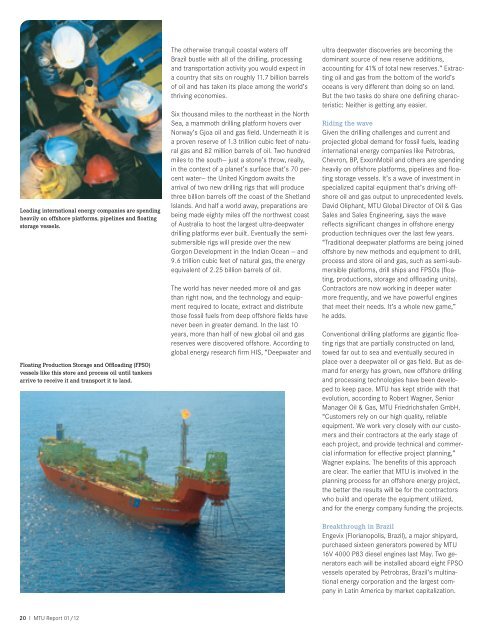



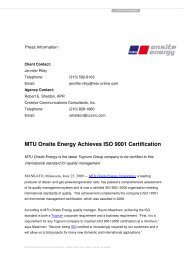

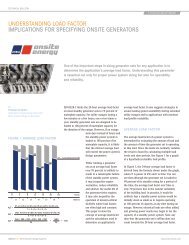


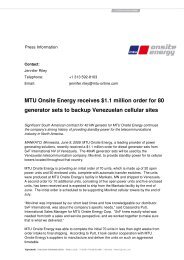
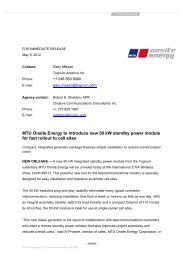


![Full power range of diesel generator sets [PDF] - MTU Onsite Energy](https://img.yumpu.com/28297693/1/190x253/full-power-range-of-diesel-generator-sets-pdf-mtu-onsite-energy.jpg?quality=85)
